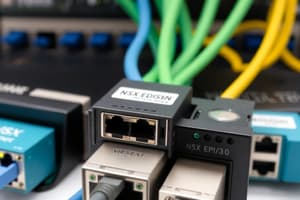Podcast
Questions and Answers
What is the first step in the cluster removal process?
What is the first step in the cluster removal process?
- Decommission storage associated with the cluster
- Log in to the vCenter Server
- Identify and select the cluster to be removed (correct)
- Disconnect network components
Migrating workloads from the selected cluster is optional before removal.
Migrating workloads from the selected cluster is optional before removal.
False (B)
What must be initiated to begin the cluster removal in VMware vCenter Server?
What must be initiated to begin the cluster removal in VMware vCenter Server?
Cluster removal process
It is important to understand and address all __________ with other clusters during removal.
It is important to understand and address all __________ with other clusters during removal.
Match the following components with their significance in the cluster removal process:
Match the following components with their significance in the cluster removal process:
Which of the following is a post-removal action?
Which of the following is a post-removal action?
Disconnecting network components should be done after migrating workloads.
Disconnecting network components should be done after migrating workloads.
What should be done with orphaned configuration files post-cluster removal?
What should be done with orphaned configuration files post-cluster removal?
To avoid service disruption, critical services should be __________ first during migration.
To avoid service disruption, critical services should be __________ first during migration.
What should be checked to ensure successful cluster removal?
What should be checked to ensure successful cluster removal?
What should be verified before proceeding with the removal of a cluster?
What should be verified before proceeding with the removal of a cluster?
It is not necessary to document any changes made during the cluster removal process.
It is not necessary to document any changes made during the cluster removal process.
What is a key precaution to take in case of unexpected problems during cluster removal?
What is a key precaution to take in case of unexpected problems during cluster removal?
To prevent unauthorized access during the removal process, maintain appropriate ______.
To prevent unauthorized access during the removal process, maintain appropriate ______.
Match the following aspects of cluster removal with their descriptions:
Match the following aspects of cluster removal with their descriptions:
What should be done with the cluster configuration before and after removal?
What should be done with the cluster configuration before and after removal?
It is unnecessary to review error messages during the clustering removal process.
It is unnecessary to review error messages during the clustering removal process.
What should be maintained throughout the cluster removal process for security?
What should be maintained throughout the cluster removal process for security?
All changes during the cluster removal should be documented for ______.
All changes during the cluster removal should be documented for ______.
What is one recommended action if a cluster removal process fails?
What is one recommended action if a cluster removal process fails?
What is the first consideration before removing a cluster?
What is the first consideration before removing a cluster?
It is required to have administrator privileges to remove a cluster.
It is required to have administrator privileges to remove a cluster.
What should be done to ensure applications and services are ready for cluster removal?
What should be done to ensure applications and services are ready for cluster removal?
After deleting a cluster, it is essential to verify _____ of all resources associated with it.
After deleting a cluster, it is essential to verify _____ of all resources associated with it.
Match the following pre-removal actions with their descriptions:
Match the following pre-removal actions with their descriptions:
Which of the following is NOT a potential issue during cluster removal?
Which of the following is NOT a potential issue during cluster removal?
Reviewing the logs after cluster removal is optional.
Reviewing the logs after cluster removal is optional.
What should be done if errors occur during the cluster removal process?
What should be done if errors occur during the cluster removal process?
It is important to have a valid plan for _____ before initiating cluster removal.
It is important to have a valid plan for _____ before initiating cluster removal.
What is one of the last steps after a cluster has been removed?
What is one of the last steps after a cluster has been removed?
What is a preferred method for managing resources during cluster removal?
What is a preferred method for managing resources during cluster removal?
Creating a detailed removal checklist is unnecessary in the cluster removal process.
Creating a detailed removal checklist is unnecessary in the cluster removal process.
What should be prioritized when planning outages during cluster removal?
What should be prioritized when planning outages during cluster removal?
It is essential to regularly review and audit __________ for accurate statuses.
It is essential to regularly review and audit __________ for accurate statuses.
Match the following actions with their significance in the cluster removal process:
Match the following actions with their significance in the cluster removal process:
What should be checked before proceeding with the removal of a cluster?
What should be checked before proceeding with the removal of a cluster?
Scripting and automation are not recommended for scaling cluster removal processes.
Scripting and automation are not recommended for scaling cluster removal processes.
What aspect should be considered to minimize service disruption during migrations?
What aspect should be considered to minimize service disruption during migrations?
Regular review of __________ is essential to align expectations during the removal process.
Regular review of __________ is essential to align expectations during the removal process.
What is a critical consideration to minimize service interruptions during cluster removal?
What is a critical consideration to minimize service interruptions during cluster removal?
Data integrity should not be maintained during the cluster removal process.
Data integrity should not be maintained during the cluster removal process.
What should be updated to reflect the changes resulting from cluster removal?
What should be updated to reflect the changes resulting from cluster removal?
During migrations, critical services should be __________ first.
During migrations, critical services should be __________ first.
Match the following post-removal tasks with their descriptions:
Match the following post-removal tasks with their descriptions:
What should be secured during the cluster removal process?
What should be secured during the cluster removal process?
It is unnecessary to maintain communication channels with stakeholders during cluster removal.
It is unnecessary to maintain communication channels with stakeholders during cluster removal.
To ensure operational stability, it is important to monitor the __________ of the remaining components.
To ensure operational stability, it is important to monitor the __________ of the remaining components.
Backing up data during cluster removal is an optional task.
Backing up data during cluster removal is an optional task.
What is critical to ensure before starting the cluster removal process?
What is critical to ensure before starting the cluster removal process?
Creating and testing backup procedures is unnecessary before cluster removal.
Creating and testing backup procedures is unnecessary before cluster removal.
What should be done with all VMs in the cluster before removal?
What should be done with all VMs in the cluster before removal?
Before removing a cluster, a comprehensive __________ of services and applications must be conducted.
Before removing a cluster, a comprehensive __________ of services and applications must be conducted.
Match the following steps with their significance during cluster removal:
Match the following steps with their significance during cluster removal:
What must be monitored after the cluster has been removed?
What must be monitored after the cluster has been removed?
It is advisable to document all changes made during the cluster removal process.
It is advisable to document all changes made during the cluster removal process.
What should be verified regarding databases after migration following cluster removal?
What should be verified regarding databases after migration following cluster removal?
A thorough __________ cleanup should be conducted after cluster removal.
A thorough __________ cleanup should be conducted after cluster removal.
Which of the following is NOT a step involved in cluster removal?
Which of the following is NOT a step involved in cluster removal?
Flashcards
Cluster Dependency Verification
Cluster Dependency Verification
Before removing a cluster, ensure all required dependencies like storage, databases, or networking are accounted for.
Configuration Update
Configuration Update
Ensure the cluster configuration is updated before and after removal to prevent future issues.
Documentation
Documentation
Document all changes and decisions made during cluster removal for future reference.
Error Handling
Error Handling
Signup and view all the flashcards
Troubleshooting
Troubleshooting
Signup and view all the flashcards
Rollback Procedures
Rollback Procedures
Signup and view all the flashcards
Data Migration
Data Migration
Signup and view all the flashcards
Access Control
Access Control
Signup and view all the flashcards
Authentication
Authentication
Signup and view all the flashcards
Auditing
Auditing
Signup and view all the flashcards
VCF Cluster Removal
VCF Cluster Removal
Signup and view all the flashcards
Phased Removal
Phased Removal
Signup and view all the flashcards
Migration Impact
Migration Impact
Signup and view all the flashcards
Decommissioning Storage
Decommissioning Storage
Signup and view all the flashcards
VCF Management UI
VCF Management UI
Signup and view all the flashcards
Cluster Interdependencies
Cluster Interdependencies
Signup and view all the flashcards
Post-Removal Validation
Post-Removal Validation
Signup and view all the flashcards
Orphaned Resources
Orphaned Resources
Signup and view all the flashcards
Workloads Migration
Workloads Migration
Signup and view all the flashcards
Regular Maintenance
Regular Maintenance
Signup and view all the flashcards
Network Connectivity Check
Network Connectivity Check
Signup and view all the flashcards
Planned Outage
Planned Outage
Signup and view all the flashcards
Removal Checklist
Removal Checklist
Signup and view all the flashcards
Point of Contact
Point of Contact
Signup and view all the flashcards
Regular Resource Audit
Regular Resource Audit
Signup and view all the flashcards
Security Policy Validation
Security Policy Validation
Signup and view all the flashcards
PowerShell Cmdlets
PowerShell Cmdlets
Signup and view all the flashcards
Script Development
Script Development
Signup and view all the flashcards
Communication with Stakeholders
Communication with Stakeholders
Signup and view all the flashcards
Cluster Removal Prerequisites
Cluster Removal Prerequisites
Signup and view all the flashcards
Common Considerations
Common Considerations
Signup and view all the flashcards
vSphere Web Client for Removal
vSphere Web Client for Removal
Signup and view all the flashcards
Cluster Resource Deletion
Cluster Resource Deletion
Signup and view all the flashcards
Post-Removal Verification
Post-Removal Verification
Signup and view all the flashcards
Troubleshooting Removal
Troubleshooting Removal
Signup and view all the flashcards
Cluster Removal Impact
Cluster Removal Impact
Signup and view all the flashcards
Regular Maintenance Post-Removal
Regular Maintenance Post-Removal
Signup and view all the flashcards
Domain Health Check
Domain Health Check
Signup and view all the flashcards
Performance Monitoring
Performance Monitoring
Signup and view all the flashcards
Documentation Update
Documentation Update
Signup and view all the flashcards
Service Interruptions
Service Interruptions
Signup and view all the flashcards
Data Integrity
Data Integrity
Signup and view all the flashcards
Errors and Issues
Errors and Issues
Signup and view all the flashcards
Cluster Decommissioning
Cluster Decommissioning
Signup and view all the flashcards
Backup and Restore Strategy
Backup and Restore Strategy
Signup and view all the flashcards
Service Dependency Identification
Service Dependency Identification
Signup and view all the flashcards
Cluster Removal within vCenter
Cluster Removal within vCenter
Signup and view all the flashcards
Resource Cleanup
Resource Cleanup
Signup and view all the flashcards
Impact Assessment
Impact Assessment
Signup and view all the flashcards
Study Notes
Prerequisites
- Ensure administrator privileges.
- Back up all cluster data.
- Migrate, terminate, or prepare VMs/services for removal.
- Confirm no other services rely on the cluster.
- Understand VMware Cloud Foundation (VCF) architecture and functionality.
- Sufficient VCF domain admin privileges.
- Backup and restore procedures for the cluster.
- Understand cluster impact on the VCF domain.
- Understand cluster dependencies and services.
- Perform a comprehensive assessment of the cluster's role within the VCF domain, identifying dependent services and applications.
- Maintain detailed inventory of VMs, services, and configurations within the cluster.
- Create and rigorously test backup procedures for all data and configurations before removing the cluster.
- Evaluate the impact of cluster removal on remaining resources, ensuring sufficient capacity and resources on remaining nodes.
- Identify and document all services and apps dependent on the cluster, planning alternative hosting solutions for continuity.
Cluster Removal Process
- Select the cluster, considering workload and service impact.
- Migrate critical workloads before removal; if not possible, cooperate with application teams for seamless migration. Plan for alternatives such as hibernation or pausing.
- Decommission cluster storage.
- Disconnect network components.
- Identify cluster applications/services and ensure compatibility with new environments.
- Understand and plan for downtime.
- Verify cluster component compatibility (vCenter, vSAN, ESXi) with the target environment if migrating.
- Address potential service interruptions to applications and users.
Cluster Removal Steps
- Log in to the vSphere Web Client.
- Navigate to the vCenter Server inventory.
- Select the cluster for removal.
- Initiate cluster removal via vSphere Web Client's 'Manage' function.
- Follow on-screen instructions (may vary based on environment/configuration; often managed by vCenter operations via command-line interfaces).
- Delete cluster from vCenter inventory.
- Verify complete removal of cluster resources from vCenter server inventory.
- Address dependent tasks/processes according to plan after removal.
- Shutdown VMs where migration isn't possible.
- Gracefully shut down cluster services, respecting dependencies.
- Verify all services have fully stopped, identifying/stopping any lingering processes.
- Initiate the cluster removal process within vCenter Server, validating prerequisites.
Post-Removal Actions
- Review logs and reports to confirm successful removal.
- Verify all cluster-associated resources are removed.
- Re-architect deployments in vSphere as necessary.
- Verify remaining infrastructure functions without issues.
- Clean up orphaned configuration files/resources.
- Monitor VCF components for stability and functionality.
- Validate removal and recovery processes for future configurations.
- Schedule maintenance procedures on involved components.
- Validate the stability of the remaining VCF domain.
- Monitor performance of remaining components, including vCenter.
- Update documentation to reflect changes.
- Document final state and configuration adjustments.
Considerations and Impact
- Plan and execute workload/application migration to avoid disruptions, prioritizing critical services.
- Understand and address interdependencies with other clusters/components (shared storage, databases, network).
- Ensure cluster configuration is updated before and after removal to prevent issues. Document changes and decisions.
- Minimize service disruptions during and after cluster removal. Plan fallback mechanisms for temporary outages.
- Maintain data consistency during removal and migrations. Maintain data backups throughout the process.
- Secure sensitive data/configurations during the process.
- Maintain communication channels with stakeholders, keeping them informed about the process and timelines.
Troubleshooting
- Verify cluster dependencies for removal before proceeding.
- Review error messages during removal failures.
- Establish escalation procedures for removal failures.
- Define a rollback procedure with backup configuration for unexpected issues.
- Plan for potential data loss during migration.
- Examine inventory for orphaned/dependent resources causing problems.
- Check affected VM network connectivity to components, ensuring proper networking.
- Consult VMware documentation/support if needed. Ensure no unresolved tasks.
- During cluster removal, pay particular attention to errors/unexpected behavior. Investigate and resolve errors efficiently.
- Post-removal, rigorously check dependent services, applications, and system operation.
Security
- Maintain appropriate access controls.
- Follow security best practices and review potential risks.
- Use appropriate authentication methods and ensure secure removal requests.
- Maintain and review audit logs for removal activities.
Alternative Methods
- VMware's methods are preferred. However, third-party tools might automate cluster removal or management.
- PowerShell cmdlets can automate cluster removal and management.
Important Considerations for a Planned Approach
- Plan outages and downtime strategically, minimizing user impact on business-critical applications.
- Communicate the process and expected downtime to all stakeholders.
- Create a detailed removal checklist.
- Designate a point of contact for issues/follow-up.
- Regularly review and audit vCenter resources and components for accuracy.
- Revalidate environment specifics like security policies.
Studying That Suits You
Use AI to generate personalized quizzes and flashcards to suit your learning preferences.




